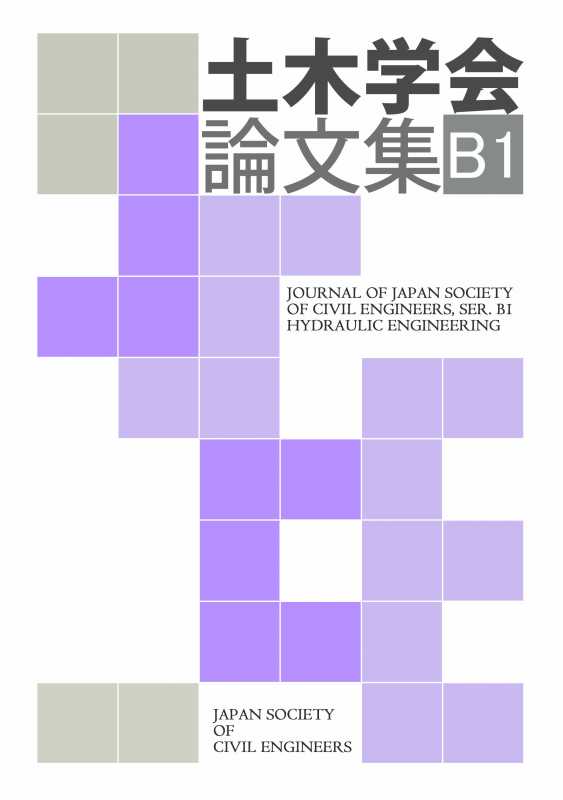Volume 77, Issue 1
Displaying 1-25 of 25 articles from this issue
- |<
- <
- 1
- >
- >|
Special Topic (SPECIAL ISSUE ON THE JULY 2020 HEAVY RAINFALL EVENT IN JAPAN)
-
2021Volume 77Issue 1 Pages 230-233
Published: 2021
Released on J-STAGE: December 20, 2021
Download PDF (390K)
Special Topic (SPECIAL ISSUE ON THE JULY 2020 HEAVY RAINFALL EVENT IN JAPAN) Paper (In Japanese)
-
2021Volume 77Issue 1 Pages 136-142
Published: 2021
Released on J-STAGE: December 20, 2021
Download PDF (1655K) -
2021Volume 77Issue 1 Pages 203-214
Published: 2021
Released on J-STAGE: December 20, 2021
Download PDF (9548K) -
2021Volume 77Issue 1 Pages 215-223
Published: 2021
Released on J-STAGE: December 20, 2021
Download PDF (9988K) -
2024Volume 77Issue 1 Pages 234-244
Published: 2024
Released on J-STAGE: May 20, 2024
Download PDF (1317K)
Special Topic (SPECIAL ISSUE ON THE JULY 2020 HEAVY RAINFALL EVENT IN JAPAN) Technical Report (In Japanese)
-
2021Volume 77Issue 1 Pages 143-149
Published: 2021
Released on J-STAGE: December 20, 2021
Download PDF (445K) -
2021Volume 77Issue 1 Pages 150-157
Published: 2021
Released on J-STAGE: December 20, 2021
Download PDF (5223K) -
2021Volume 77Issue 1 Pages 158-166
Published: 2021
Released on J-STAGE: December 20, 2021
Download PDF (10059K) -
2021Volume 77Issue 1 Pages 167-173
Published: 2021
Released on J-STAGE: December 20, 2021
Download PDF (1119K) -
2021Volume 77Issue 1 Pages 174-184
Published: 2021
Released on J-STAGE: December 20, 2021
Download PDF (6800K) -
2021Volume 77Issue 1 Pages 191-202
Published: 2021
Released on J-STAGE: December 20, 2021
Download PDF (3705K) -
2021Volume 77Issue 1 Pages 224-229
Published: 2021
Released on J-STAGE: December 20, 2021
Download PDF (4264K)
Special Topic (SPECIAL ISSUE ON THE JULY 2020 HEAVY RAINFALL EVENT IN JAPAN) Technical Note (In Japanese)
-
2021Volume 77Issue 1 Pages 185-190
Published: 2021
Released on J-STAGE: December 20, 2021
Download PDF (5462K)
Paper (In Japanese)
-
2021Volume 77Issue 1 Pages 12-23
Published: 2021
Released on J-STAGE: January 20, 2021
Download PDF (6847K) -
2021Volume 77Issue 1 Pages 24-38
Published: 2021
Released on J-STAGE: January 20, 2021
Download PDF (2639K) -
2021Volume 77Issue 1 Pages 39-53
Published: 2021
Released on J-STAGE: March 20, 2021
Download PDF (8282K) -
2021Volume 77Issue 1 Pages 54-58
Published: 2021
Released on J-STAGE: April 20, 2021
Download PDF (889K) -
2021Volume 77Issue 1 Pages 59-73
Published: 2021
Released on J-STAGE: June 20, 2021
Download PDF (1741K) -
2021Volume 77Issue 1 Pages 74-83
Published: 2021
Released on J-STAGE: July 20, 2021
Download PDF (1854K) -
2021Volume 77Issue 1 Pages 84-91
Published: 2021
Released on J-STAGE: July 20, 2021
Download PDF (2817K) -
2021Volume 77Issue 1 Pages 98-110
Published: 2021
Released on J-STAGE: December 20, 2021
Download PDF (2879K) -
2021Volume 77Issue 1 Pages 111-123
Published: 2021
Released on J-STAGE: December 20, 2021
Download PDF (3159K) -
2021Volume 77Issue 1 Pages 124-135
Published: 2021
Released on J-STAGE: December 20, 2021
Download PDF (1532K)
Technical Report (In Japanese)
-
2021Volume 77Issue 1 Pages 1-11
Published: 2021
Released on J-STAGE: January 20, 2021
Download PDF (3074K)
Technical Note (In Japanese)
-
2021Volume 77Issue 1 Pages 92-97
Published: 2021
Released on J-STAGE: September 20, 2021
Download PDF (2439K)
- |<
- <
- 1
- >
- >|
